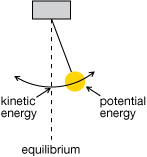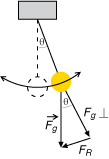Module 7—Oscillatory Motion
 Explore
Explore
Observing Simple Harmonic Motion

Hundreds of years ago, Galileo Galilei watched a candle-burning chandelier swinging back and forth on a long chain in a cathedral. Galileo wondered what determined the period of the chandelier. What effect would changing the length of the chain have? If the mass of the chandelier were changed, would that affect the period of vibration? If the amplitude (size of swing) was increased or decreased, would the period be affected? To answer these questions, Galileo did an experiment similar to the one you are about to do.
At rest, a pendulum hangs at the equilibrium position. The pendulum is given potential energy when the bob is pulled to one side. This would be considered the starting position. When it is released, the pendulum is pulled by gravity toward the equilibrium positiosn. The potential energy is converted into kinetic energy until the pendulum reaches its maximum speed (at the equilibrium position). The pendulum then continues through the equilibrium position to end up on the opposite side from where it started at rest for an instant. The kinetic energy has been converted back into potential energy. Then gravity pulls the pendulum back through the equilibrium position until it reaches its starting position again. One cycle or vibration has been completed.
A moving pendulum exhibits simple harmonic motion only when the amplitude of the motion is small. This means that when the amplitude is small, the pendulum is vibrating with a constant frequency or period of motion and there is a restoring force directed towards a central equilibrium point. Furthermore, for small displacements, the magnitude of the restoring force is proportional to the displacement from the equilibrium point (as described by Hooke’s law).
Determining the Restoring Force of a Pendulum

When a mass is attached to the end of a hanging string and is pulled from its equilibrium position, its displacement is defined by angle θ (as illustrated here). When the pendulum is released, a component of the gravitational force will cause the mass to accelerate towards the equilibrium position, along the arc. This component is called the restoring force (FR), and it can be expressed in terms of the gravitational force using the appropriate trigonometric function.
The restoring force of a pendulum is the component of gravity that acts along the arc to pull the mass back towards the equilibrium position. Expressed as an equation, it is

| Quantity | Symbol | SI Unit |
| restoring force | FR | N |
| angle between pendulum and equilibrium point | θ | degrees |
| force due to gravity | Fg | N |
This equation only works when a pendulum is exhibiting simple harmonic motion. When the angle of release is larger than 15°, the pendulum no longer exhibits simple harmonic motion. See page 361 of your textbook for a complete explanation of this fact.
 Read
Read
How is the simple harmonic motion of a pendulum different than the weighted spring studied in the previous lesson? Read “Simple Harmonic Motion of a Pendulum” on pages 359 to 362 of your textbook, and look for differences.
Example Problem 1
A 27.0-kg child plays on a swing, oscillating back and forth without pumping. What is the maximum restoring force that acts on the child when the swing oscillates with a maximum displacement of 10.0°?
Solution
The maximum restoring force occurs when the maximum displacement angle is reached. In this case, the maximum displacement is 10.0°.

Correct to 3 significant digits, the maximum restoring force that acts on the child is 46.0 N.
 Module 7: Lesson 2 Assignment
Module 7: Lesson 2 Assignment
Remember to submit the answers to TR 1, TR 2, and TR 3 to your teacher as part of your Module 7: Lesson 2 Assignment.
 Try This
Try This
TR 1. Calculate the restoring force that acts on a 1.0-kg hanging mass when it is displaced 2.0° from equilibrium.
TR 2. Calculate the restoring force that acts on a 1.0-kg hanging mass when it is displaced 10° from equilibrium.
TR 3. Based on your answers from TR 1 and TR 2, what is the relationship between the magnitude of the restoring force and the angle of displacement from equilibrium?